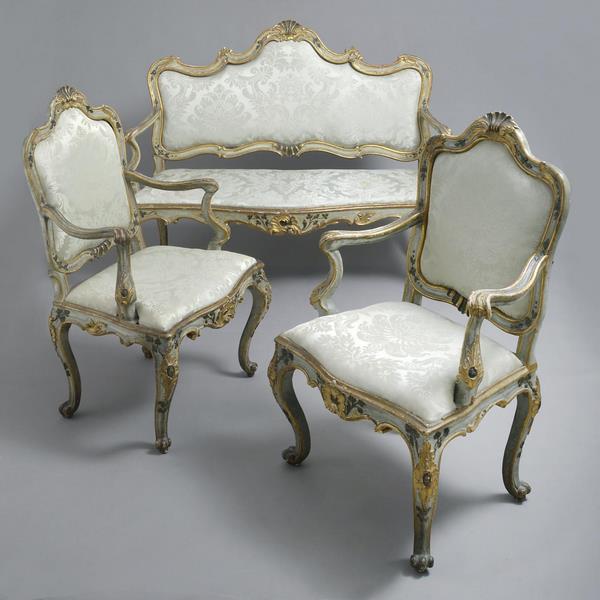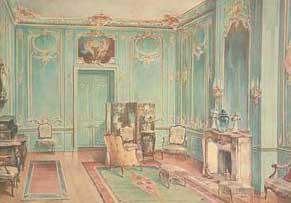Now we get a grasp of what’s going on in the 17th century. Now I wonder, What happened during the 18th century? What was it like to live in the 1800s? Let’s learn more ideas about the culture, life, and furniture that’s happening in the 18th century.
On the frontier in the 18th-century life was very rough and people often lived in log cabins. In the period between the 1670s and 1750s, sweeping changes transformed both the public social lives and private family lives of the British people. Increased literacy, combined with The Restoration led the British people to increasingly public life. There were also clear class distinctions that were prevalent in the realms of both home life, outward social life, and education. New developments in recreation, commercialization, and industrialization also led to a transformation in both entertainment and occupations available. Additionally, new fashion trends came onto the scene.

18th Century Colonial Ball | Source: google.com
Rococo Style
There was a clear gap between the wealthy and the poor. Which made itself visible in almost all aspects of life, but there were certain areas where the class was unimportant. Now let’s talk about the furniture, We all know what word popped up when we’re discussing the 18th century. Yes, that’s right. It’s Rococo. Rococo style is an ornate style originating in France in the 18th century and evolving from the Baroque style. Rococo art was defined by a strict rejection of Baroque sensibilities, but what does this mean in terms of sofas? In this article, we’re going to see how Rococo manifested in furniture.
Rococo is applied to the Louis XV period in France (1715-1774)
The word is derived from “rocaille” (pebble), but the term referred especially to the small stones and shells used to decorate the interiors of grottoes. Such shells or shell forms were the principal motifs in Rococo ornament. Louis XIV died in 1715 after a reign of 72 years, and there arose in Paris new types of private patrons — nobles created by the sale of offices, nouveau riche tax collectors, and millionaires and bankers fat on the spoils of financing 25 years of disastrous wars. They luxuriated in new artistic freedom, indulged their highly individualistic tastes, and welcomed fresh ideas in decoration. A society devoted to material comfort and preoccupied with personal pleasure demanded constant variety, surprise, and originality.

Mid-18th Century Rococo Canape & Open Armchairs | Source: Timothy Langston
The French nobles abandoned Versailles after 1715 for the pleasures of town life. The “hotels” (townhouses) of Paris soon became the centers of a new, softer style we call “rococo.” Rococo appeared in France in about 1700, primarily as a style of interior design. The French Rococo exterior was most often simple, or even plain, but Rococo exuberance took over the interior.
The feminine look of the Rococo style
The feminine look of the Rococo style suggests that the age was dominated by the taste and the social initiative of women, and, to a large extent it was. Women — Madame de Pompadour in France, Maria Theresa in Austria, Elizabeth and Catherine in Russia — held some of the highest positions in Europe. The Rococo salon was the center of early 18th-century Parisian society, and Paris was the social center of Europe. French Rococo interiors were designed as lively, total works of art in which the architecture, relief sculptures, and wall paintings were complemented by elegant furniture, enchanting small sculptures, ornamented mirror frames, delightful ceramics, and silver, a few “easel” paintings, and decorative tapestry.

Louis XV Furniture – French Rococo | Source: google.com
The Difference Between Baroque and Rococo Style
While Baroque was opulent and heavier –more “serious” – Rococo is considered more lighthearted, frivolous, fantastical, and whimsical. The decoration was typically used to create a sense of flow, particularly using abstract and asymmetrical detail. Often, it also included Asian influences like chinoiseries. Trade with the Far East influenced decorative motifs, and these patterns and lacquer work became increasingly fashionable. When you look at Baroque and Rococo furniture, they seem quite similar. Both are heavily decorated, have curvaceous legs – sometimes animal legs — and feature intricate embellishments of scrolls, leaves, and shells. But look closer and the differences start to emerge:
Rococo furniture is more delicate and feminine and uses lighter shades of ivory, gold, and pastel colors. Chairs legs that are thinner, seats that have an organic form, and wider arms. Moreover, symmetry is not critical. Upholstery in the Rococo style is similar to that of Baroque, but it includes brocatelle and flowered or painted silks. Rococo interiors often highlight large candelabras, magnificent chandeliers, and wall sconces, used to create a cozy space. Mirrors also feature prominently to intensify the feeling of open space. Their opulently gilded frames often hung on walls with floral carvings.
Art
While both styles give prominence to the arts, Rococo art uses pastel colors, serpentine curves and features lighter topics such as romantic love and portraiture. Baroque art is darker, more dramatic, and theatrical. Not to mention, Rococo architecture was a lighter, more graceful, yet also more elaborate version of Baroque architecture, which was ornate and austere. While the styles were similar, there are some notable differences between both Rococo and Baroque architecture, such as symmetry;
Style
Rococo emphasized the asymmetry of forms, while Baroque was the opposite. The styles, despite both being richly decorated, also had different themes; the Baroque was more serious, placing an emphasis on religion, and was often characterized by Christian themes (the Baroque began in Rome as a response to the Protestant Reformation);
The Rococo Architecture
The rococo architecture was an 18th century, more secular, adaptation of the Baroque that was characterized by more light-hearted and jocular themes. Other elements belonging to the architectural style of Rococo include numerous curves and decorations, as well as the use of pale colors. Such as the Catherine Palace in Russia, the Queluz National Palace in Portugal, the Augustusburg and Falkenlust Palaces in Brühl, Château de Versailles in France, and others.
Conclusion
The conclusion is Furniture in the Rococo period was freestanding, as opposed to wall-based, in order to accentuate the lighthearted and versatile atmosphere that was desired by the aristocracy. Mahogany became the most widely used medium due to its strength, and mirrors also became increasingly popular.

The Catherine Palace, Russia | Source: google.com
